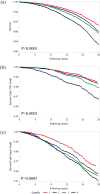Circulating N-Linked Glycoprotein Acetyls and Longitudinal Mortality Risk
- PMID: 26951635
- PMCID: PMC4836171
- DOI: 10.1161/CIRCRESAHA.115.308078
Circulating N-Linked Glycoprotein Acetyls and Longitudinal Mortality Risk
Abstract
Rationale: Circulating glycoprotein N-acetyl glucosamine residues have recently been associated with incident cardiovascular disease and diabetes mellitus.
Objective: Using a plasma glycan biosignature (GlycA) to identify circulating N-acetyl glycan groups, we examined the longitudinal association between GlycA and mortality among initially healthy individuals.
Methods and results: We quantified GlycA by 400 MHz (1)H nuclear magnetic resonance spectroscopy in 27,524 participants in the Women's Health Study (NCT00000479). The primary outcome was all-cause mortality. We replicated the findings in an independent cohort of 12,527 individuals in the Justification for the Use of statins in Prevention: an Intervention Trial Evaluating Rosuvastatin (JUPITER) trial (NCT00239681). We also undertook secondary examination of cardiovascular disease and cancer mortality in the Women's Health Study. In the Women's Health Study, during 524,515 person-years of follow-up (median, 20.5 years), there were 3523 deaths. Risk factor-adjusted multivariable Cox proportional hazard ratio (95% confidence interval) per SD increment in GlycA for all-cause mortality was significantly increased at 5 years (1.21 [1.06-1.40]) and during maximal follow-up (1.14 [1.09-1.16]). Similar risk for all-cause mortality was observed in the replication cohort (1.33 [1.21-1.45]). In the Women's Health Study, risk of cardiovascular disease mortality was increased at 5 years (1.43 [1.05-1.95]) and during maximal follow-up (1.15 [1.04-1.26]) and of cancer mortality at 5 years (1.23 [1.02-1.47]) and during maximal follow-up (1.08 [1.01-1.16]). Examination of correlations and mortality associations adjusted for high-sensitivity C-reactive protein, fibrinogen, and intercellular adhesion molecule-1, suggested that GlycA reflects summative risk related to multiple pathways of systemic inflammation.
Conclusions: Among initially healthy individuals, elevated baseline circulating glycoprotein N-acetyl methyl groups were associated with longitudinal risk of all-cause, cardiovascular, and cancer mortality.
Keywords: cardiovascular diseases; glycoproteins; magnetic resonance spectroscopy; metabolomics; mortality; neoplasms; risk factors.
© 2016 American Heart Association, Inc.
Figures



References
Publication types
MeSH terms
Substances
Associated data
Grants and funding
LinkOut - more resources
Full Text Sources
Other Literature Sources
Medical
Research Materials

